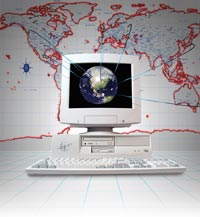|
Information in this section is extracted from the 2002 World
Telecommunication Development Report: Reinventing Telecoms, written by the ITU
Telecommunication Development Bureau’s Data and Statistics Unit in
collaboration with the Policy and Strategy Unit (SPU). This sixth edition of ITU’s
World Telecommunication Development Report points the way for planners to
reinvent access to services. Throughout its history, the telecommunication
sector has reinvented itself; as the driver of growth it has shifted from data
(the telegraph), to voice (telephone) and back again to data (the Internet).
According to the report, it appears that the industry is once again at such a
crossroads, as technological change intersects with new market realities.

The telecommunication sector has reinvented itself; as
the driver of growth it has shifted from data
(the telegraph), to voice (telephone) and back again to data (the
Internet)
PhotoDisc (ITU 020052)
|
The indicators provided here have been selected to give our
readers some insights into how the telecommunication world is faring as ITU
Members prepare to celebrate World Telecommunication Day on 17 May 2002 to
commemorate its founding in Paris in 1865. This year’s theme “Information
and communication technologies for all: Empowering people to cross the digital
divide” captures many of the most important challenges facing ITU and its
membership in the twenty-first century.
Note that Reinventing Telecoms was written in early 2002.
Thus, figures for year-end 2001 are provisional and subject to revision.
Information technology
Throughout the column on information technology, “Internet
hosts” refer to the number of computers in the economy that are directly
linked to the worldwide Internet network. Note that Internet host computers are
identified by a two-digit country code or a three-digit code generally
reflecting the nature of the organization using the Internet computer. The
number of hosts are assigned to countries based on the country code although
this does not necessarily indicate that the host is actually physically in the
country or economy. In addition, all other hosts for which there is no country
code identification are assigned to the United States. Therefore the number of
Internet hosts shown for each country or economy can only be considered an
approximation. Data on Internet host computers come from Internet Software
Consortium (http://www.isc.org) and RIPE (http://www.ripe.net). “Users” are
based on reported estimates, derivations based on reported Internet Access
Provider subscriber counts, or calculated by multiplying the number of hosts by
an estimated multiplier. “Estimated PCs” shows the number of personal
computers, both in absolute numbers and in terms of PC ownership per 100
inhabitants. These numbers are derived from the annual questionnaire
supplemented by other sources.
|